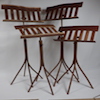Hey guys,
I am working on a project that requires three mahogany stop-fluted half columns. The columns are 6 3/4 wide and I already got a knife ground that will do two flutes at a time (There are 4 total flutes on the face, 1/2" radius).
My question is: how does one safely and efficiently "drop cut" on a shaper while the material is on edge, and then terminate the cut before the end? I ran a couple of trials just by using the end of my fence as a pivot but the shaper really wants to grab ahold of the material. Anyone have a jig for this? I know the best way to do this would be a W&H style molder but I don't have one.
Thanks
Jack






 Reply With Quote
Reply With Quote




